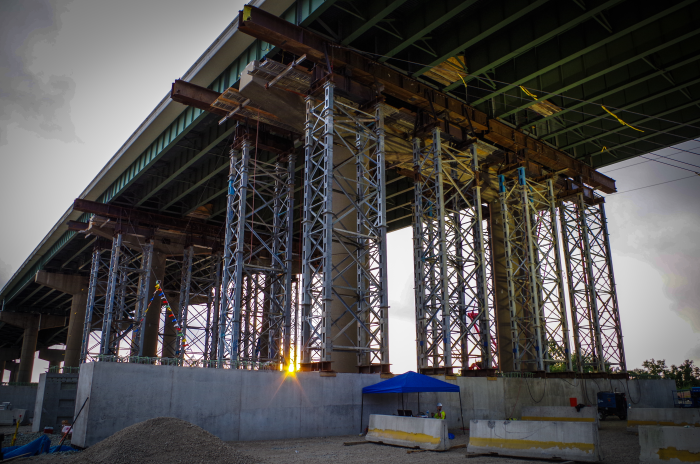


デラウェア州運輸省 (DelDOT) は、Intelligent Infrastructure Systems (IIS) と Pennoni に対し、Bridge 1-813 の 11 から 14 までのスパンと 15 の橋脚の上部構造と下部構造の緊急実地検査が必要であることを通知しました。デラウェア州ウィルミントンにあるこの橋は、北行きと南行きの州間高速道路 495 号線の交通を運ぶ 2 つの構造物で構成されています。独立したマルチビーム上部構造と、構造の各半分の下に独立して支えられたハンマーヘッド橋脚が特徴で、1 日あたり 90,000 台の車両が通行します。
DelDOT から問題が報告されてから 40 分以内に、IIS のエンジニアが現場に到着し、橋の状態を評価しました。橋脚 11 から 14 では、元の位置から最大 4 パーセントの横方向の回転が見られ、中央分離帯が垂直方向に最大 17 インチずれ、道路から見える状態でした。後に、この回転は、構造物のすぐ隣に設置された大規模な盛土 (推定 50,000 トン) が原因で、下にある軟弱地盤が圧縮され、橋の基礎に横方向の圧力がかかったことが原因であることが判明しました。
ベアリング、現場継ぎ目、クロスフレーム接続、デッキジョイント、デッキ上部、ハンマーヘッドピアキャップ、ピア柱はすべて、構造全体の回転と動きによって生じた損傷を評価するために、実際に検査されました。これらの回転とその他の動きを記録するために、測定値が収集されました。さらに、ピア 11 から 14 の基礎の南面に沿って露天掘りが行われ、検査のために基礎の全高と基礎の下の杭の約 18 インチが露出されました。
傾斜センサーが桟橋 10 から 15 に設置され、Campbell Scientific CR3000、2 台の AVW200、および 3 台の AM16/32B マルチプレクサを使用してリアルタイム データ収集により桟橋の回転を継続的に監視します。CR3000 は、DelDOT からの最初の呼び出しから 12 時間以内にデータを収集しました。IIS の任務には次のものが含まれます。
- DelDOTの橋梁管理部門との広範な調整
- アクセス機器プロバイダーとの調整
- すべての現場業務の監督と管理(検査と監視)
- 11~14スパンと橋脚基礎および杭の実地検査
- 構造上の調査ポイントを収集することにより、DelDOTの調査部門を支援
- DelDOT内部調整会議への出席と参加
- 発見された状況に関する中間日報の作成
- 緊急総合検査報告書の作成
橋は 2 か月以内に通行可能になりました。一時的な修理工事中、一時的なポスト テンション バーにひずみゲージが設置され、構造物が持ち上げられ、回転して元の位置に戻ってくるときにこれらの要素のひずみの変化が監視されました。持ち上げと再調整のプロセス中に動的データが必要になったため、システムは Campbell Scientific CDM-VW305 モジュールを使用して再構成され、20 ヘルツのサンプリング レートで傾斜計とひずみゲージからデータを収集するために使用されました。
恒久的な修理が完了した後、IIS は 48 台の傾斜計で構成される長期監視システムを設置しました。5 台のリモート Campbell Scientific AVW206-AM16/32B データ取得ユニットが傾斜計の読み取りと電力供給を行います。リモート ユニットは Campbell Scientific SP10/BP12 ソーラー パネルとバッテリーの組み合わせによって電力供給されます。15 分ごとに、RF401 スペクトラム拡散無線が CR3000 ベース ステーションにデータを送信し、その後 2 台の Sierra Wireless セルラー モデムがデータを DelDOT と IIS に送信します。